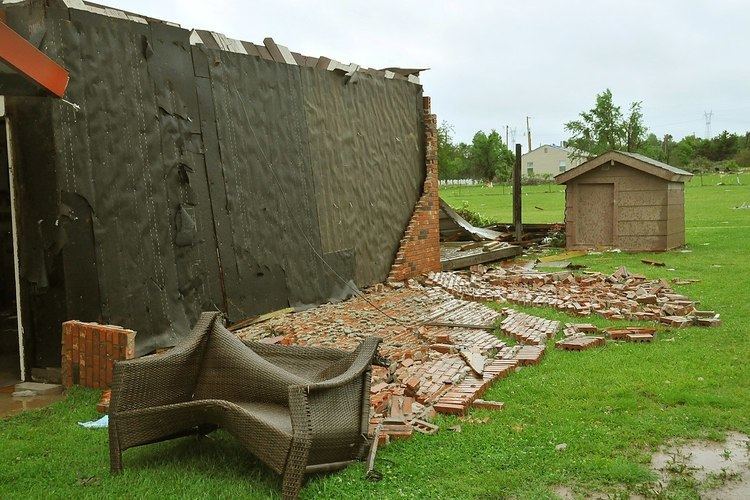 | ||
Bituminous waterproofing systems are designed to protect residential and commercial buildings. Bitumen (asphalt or coal-tar pitch) is a mixed substance made up of organic liquids that are highly sticky, viscous, and waterproof. These systems are sometimes used to construct roofs, in the form of roofing felt or roll roofing products.
Contents
Roofing felt
Roofing felt (similar to tar paper) is the base material used to make roof shingles and roll roofing. Typical uses of felt paper are as an underlay(ment) (sarking) beneath other building materials, particularly roofing and siding materials, and is one type of membrane used in asphalt built up roofing (BUR) systems. The purposes are to "...separate the roof covering from the roof deck...shed water...[and] provide secondary weather protection..." Also, the rapid application of roofing underlay protects the roof deck during construction until the roofing material is applied and is required for roofs required to meet Underwriters Laboratory (UL) fire ratings. The separation of the roof covering from the roof deck protects the roof covering from resins in some sheathing materials and cushions unevenness and old nails and splinters in re-roofing applications. The underlayment also sheds water, which penetrates the roof covering from an ordinary leak, a leak from wind-driven rain or snow, wind damage to the roof covering, or ice dams. However, the application of underlays may increase the roof temperature, which is the leading cause of ageing of asphalt shingles and felt paper wrinkles when it gets wet, which (rarely) shows through asphalt shingles. Not installing an underlay may void the roof covering warranty.
Felt paper is available in several types. The two common grades of felt paper are called Type 1 (No. 15) and Type 2 (No. 30) felt. The "15" and "30" designations originated with organic base felt weighing 15lb or 30lb per 100 sq. ft. (6.8 kg or 14 kg per 9.3 m2). Now, they may still colloquially be called 15- or 30- pound felt but are technically called No. 15 or No. 30, and the fibreglass and polyester base felts are lighter weight. Another basic designation is organic or inorganic. Organic felt paper has a base material made with formerly living materials such as rag fibre (hessian) or cellulose fibres (wood, or jute). Organic felt papers are now considered obsolete, only comprising five percent of the market in 1987. Inorganic base products are polyester, fibre glass developed in the 1950s, and historically, asbestos mat. Polyester mat is stronger than fibreglass and is gaining market share. Polyester mat is primarily used with the more flexible modified-bitumen felt products. Asbestos mat was the first inorganic base material but was outlawed in the 1980s for health reasons but is still in use on some buildings. Inorganic felts are lighter, more tear-resistant, more fire-resistant, and do not absorb water. Another type of felt paper is perforated for use in built-up roofing and is not for use as a water-resistant underlay.
These products are bought in roll format and are pulled through the bitumen mixes on huge rollers. The base product becomes saturated in huge tanks by the tar-like bitumen substance, creating rolls of water-resistant but breathable material.
The choice of which quality of underlay relates to the durability of the roofing material, such as using a double-layer of No. 30 felt or modified bitumen under slate or tile roofing or on low slope roofs (where leakage may be more likely) where a steep slope application of 25-year asphalt shingles a single layer NO. 15 felt is adequate.
Modified bitumen is mixed with filler components such as limestone, sand, or polymers such as atactic polypropylene (APP) that gives rigidity and tear resistance or styrene-butadiene styrene (SBS), a rubber additive that gives more elastic benefits.
Felt paper standards
The American Society for Testing Materials (ASTM) standards that apply to felt paper are:
The Canadian Standards Association standards are:
Roll roofing components
Roll roofing is a bitumen product that is exposed to the weather. To protect the base from ultraviolet degradation mineral granules are added on top of the felt, also decreasing the product's fire vulnerability. Thin, transparent film is added to the base of the felt during manufacturing on all torch-on products. This stops the felt from sticking to itself when rolled up during the packaging process.
Composition
The complex chemical composition of bitumen makes it difficult to identify the specific component(s) responsible for adverse health effects observed in exposed workers. Known carcinogens have been found in bitumen fumes generated at work sites. Observations of acute irritation in workers from airborne and dermal exposures to fumes and aerosols and the potential for chronic health effects, including cancer, warrant continued diligence in the control of exposures.
Reasons to use a roofing underlayment
Negative aspects
Malthoid
From 1905 to 1988 The Paraffine Paint Co. of San Francisco had Malthoid as a trademark for waterproof and weatherproof building and roofing materials made of paper and felt in whole or in part. However, it had become well known before that. About 1913 Paraffine promoted its Malthoid roofing materials with a 16 page booklet. In 1941 the Duroid Company began making Malthoid in Onehunga, New Zealand.
Malthoid was once common enough to be used as a generic description of flat roofing material in New Zealand and South Africa (item 26). A description of a New Zealand house built about 1914 says it was, "built of timber framework. covered by sheets of asbestos. The roof was closely timbered, then covered by strips of Malthoid paper. This was then painted with tar and topped off with a sprinkling of sand." Railway vehicles in Australia were roofed with Malthoid. Malthoid is still available for flat roofs and damp courses.
